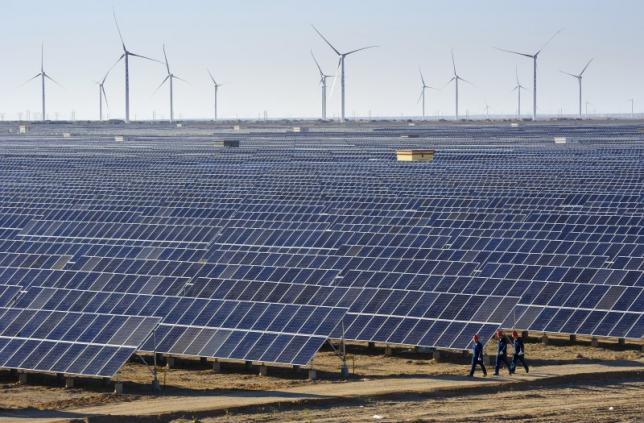China sets pace for green energy
Updated: 2016-07-11 09:04
By Zheng Jinran and Yang Jun(China Daily)
|
||||||||
 |
|
Workers walk past solar panels and wind turbines (rear) at a newly-built power plant in Hami, Xinjiang Uighur autonomous region, China, September 17, 2015. [Photo/Agencies] |
China has cut coal consumption by 1.57 billion metric tons from 2010 to 2015 to reduce carbon emissions by 3.6 billion tons. And it has shown a commitment to green energy by becoming the largest country with renewable power capacity in 2015.
An estimated 147 gigawatts of renewable power capacity was added worldwide in 2015, the largest annual increase ever, and global investment also climbed to a record high, the annual Global Status Report on Renewables 2016 said.
Among the global players, China has been especially active. It leads the list of 148 countries covered in the report, with the largest renewable power capacity by 2015, according to Irene Giner-Reichl, president of Global Forum on Sustainable Energy.
She focused on the rapid growth of renewable energy in China during the 2016 Eco Forum annual conference in Guiyang, Guizhou province, on Saturday. The forum ended on Sunday.
With the increasing investment on solar, wind and hydropower, China will see a larger growth of nonfossil fuels, "with a high possibility to exceed the set targets of 15 percent by 2020," said Li Junfeng of the Chinese Renewable Energy Industries Association.
Nonfossil fuels accounted for 12 percent of China's primary energy mix in 2015, growing from 7.4 percent in 2005, and it's expected to account for 20 percent by 2030, said Xie Zhenhua, China's chief climate negotiator and former deputy chief of the National Development and Reform Commission.
As one of largest global carbon emitters, China has implemented multiple policies, including industrial restructuring, to enhance energy efficiency and reduce carbon emissions, with significant success.
Its cut in coal consumption since 2010 was equivalent to reducing carbon emission by 3.6 billion tons, Xie said.
"In 2015, China saw its GDP hit 67.7 trillion yuan ($10.1 trillion), 148 percent above 2005, but the carbon dioxide emission per unit of GDP has been reduced by 38 percent compared with 2005," Xie said.
China is committed to reducing carbon intensity 60-65 percent by 2030, and aims to reach peak carbon dioxide emissions earlier than the deadline of 2030, Xie said.
William Ruto, vice-president of Kenya, who attended the forum, praised China's efforts in reducing carbon emissions and called for more cooperation among the African countries and China on the use of green energy.
Contact the writers at zhengjinran@chinadaily.com.cn
- Philippine, Japan coast guards to hold exercise off Manila Bay
- Dozens more arrests in Louisiana after leaders warn against protest violence
- South China Sea Issue ABC
- South China Sea Issue ABC: Why the Philippines' unilateral initiation of arbitration is against international law?
- EU: Strenghten partnerships to stop economic woes
- Fresh killings in Indian-controlled Kashmir clashes raise death toll to 21

 Gettinig to know South China Sea Issue
Gettinig to know South China Sea Issue
 Ronaldo-less Portugal wins Euro 2016 title
Ronaldo-less Portugal wins Euro 2016 title
 Chinese navy fleet joins RIMPAC 2016 open day
Chinese navy fleet joins RIMPAC 2016 open day
 Staying cool at the zoo amid Shanghai heat wave
Staying cool at the zoo amid Shanghai heat wave
 Tibet through the lens of China Daily reporter
Tibet through the lens of China Daily reporter
 On the front lines of the flood battle in China
On the front lines of the flood battle in China
 Griezmann scores twice to lift France into Euro final
Griezmann scores twice to lift France into Euro final
 Life goes on in flooded Wuhan
Life goes on in flooded Wuhan
Most Viewed
Editor's Picks

|

|

|

|

|

|
Today's Top News
Ministry slams US-Korean THAAD deployment
Two police officers shot at protest in Dallas
Abe's blame game reveals his policies failing to get results
Ending wildlife trafficking must be policy priority in Asia
Effects of supply-side reform take time to be seen
Chinese State Councilor Yang Jiechi to meet Kerry
Chinese stocks surge on back of MSCI rumors
Liang avoids jail in shooting death
US Weekly

|

|







